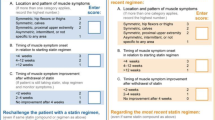Opinion statement
Although the long- and short-term safety of statin therapy is well established, statin intolerance is common in clinical practice. Muscle symptoms are the most common side effect of statin therapy and are potentially the most hazardous and the most likely to reduce patient adherence. Clinicians can establish office protocols/procedures that will reduce the number of patients with statin intolerance. Genomic variations that result in statin-associated myopathy are likely. We await diagnostic and treatment options for this group. Alternative dosing options and the use of alternative statins are useful strategies for those with muscle symptoms. Therapeutic lifestyle changes are critical to achieving maximal risk reduction but remain difficult to implement. Presently available nonstatin lipid-lowering drugs (alone or in combination) do not have the established benefit of statins but do have potential benefit in select patients.
Similar content being viewed by others
References and Recommended Reading
Baigent C, Keech A, Kearney PM, et al.: Cholesterol Treatment Trialists’ (CTT) Collaborators: Efficacy and safety of cholesterol-lowering treatment: prospective meta-analysis of data from 90,056 participants in 14 randomized trials of statins. Lancet 2005, 366:1267–1278.
Davidson MH, Robinson JG: Safety of aggressive lipid management. J Am Coll Cardiol 2007, 49:1753–1762.
McKenney JM, Davidson MH, Jacobson TA, Guyton JR: Final conclusions and recommendations of the National Lipid Association Statin Safety Assessment Task Force. Am J Cardiol 2006, 97(Suppl 1):S89–S94.
Scott RS, Lintott CJ, Wilson MJ: Simvastatin and side effects. N Z Med J 1991, 104:493–495.
Bruckert E, Hayem G, Dejager S, et al.: Mild to moderate muscular symptoms with high—dosage statin therapy in hyperlipidemic patients-the PRIMO study. Cardiovasc Drugs Ther 2005, 19:403–414.
Ballantyne CM, Herd A, Ferlic L, et al.: Heart Protection Study Collaborative Group: MRC/BHF Heart Protection Study of cholesterol lowering with simvastatin in 20,536 high-risk individuals: a randomised placebo-controlled trial. Lancet 2002, 360:7–22.
Phillips PS, Hass RH, Bannykh S, et al.: Statin-associated myopathy with normal creatine kinase levels. Ann Intern Med 2002, 137:581–585.
Marcoff L, Thompson PD: The role of coenzyme Q10 in statin-associated myopathy: a systematic review. J Am Coll Cardiol 2007, 49:2231–2237.
Caso G, Kelly P, McNurlan MA, Lawson WE: Effect of coenzyme Q10 on myopathic symptoms in patients treated with statins. Am J Cardiol 2007, 99:1409–1412.
Oh J, Ban MR, Miskie BA, et al.: Genetic determinants of statin intolerance. Lipids Health Dis 2007, 6:7.
Hansen KE, Hildebrand JP, Ferguson EE, et al.: Outcomes in 45 patients with statin-associated myopathy. Arch Intern Med 2005, 165:2671–2676.
Matalka MS, Ravnan MC, Deedwania PC: Is alternate daily dose of atorvastatin effective in treating patients with hyperlipidemia? The Alternate Day Versus Daily Dosing of Atorvastatin Study (ADDAS). Am Heart J 2002, 144:674–677.
Backes JM, Moriarty PM, Ruisinger JF, Gibson CA: Effects of once weekly rosuvastatin among patients with a prior statin intolerance. Am J Cardiol 2007, 100:554–555.
Backes JM, Venero CV, Gibson CA, et al.: Effectiveness and tolerability of every-other-day rosuvastatin dosing in patients with prior statin intolerance. Ann Pharmacother 2008, 42:341–346.
Athyros VG, Tziomalos K, Kakafika AI, et al.: Effectiveness of ezetimibe alone or in combination with twice a week atorvastatin (10 mg) for statin intolerant high-risk patients. Am J Cardiol 2008, 101:483–485.
Jenkins DJA, Kendall CWC, Marchie A, et al.: Effects of a dietary portfolio of cholesterol-lowering foods vs lovastatin on serum lipids and C-reactive protein. JAMA 2003, 290:502–551.
Canner PL, Berge KG, Wenger NK, et al.: Fifteen year mortality in Coronary Drug Project patients: long term benefit with niacin. J Am Coll Cardiol 1986, 8:1245–1255.
Brown G, Albers JJ, Fisher LD, et al.: Regression of coronary artery disease as a result of intensive lipid-lowering therapy in men with high levels of apolipoprotein B. N Engl J Med 1990, 323:1289–1298.
Zema MJ: Colesevelam HCl and ezetimibe combination therapy provides effective lipid-lowering in difficult-to-treat patients with hypercholesterolemia. Am J Ther 2005, 12:306–310.
Xydakis AM, Guyton JR, Chiou P, et al.: Effectiveness and tolerability of ezetimibe add-on therapy to a bile acid resin-based regimen for hypercholesterolemia. Am J Cardiol 2004, 94:795–797.
Rubins HB, Robins SJ, Collins D, et al.: Gemfibrozil for the secondary prevention of coronary heart disease in men with low levels of high-density lipoprotein cholesterol. N Engl J Med 1999, 341:410–418.
Scott R, O’Brien R, Fulcher G, et al.: Effects of fenofibrate treatment on cardiovascular disease risk in 9,795 individuals with type 2 diabetes and various components of the metabolic syndrome. Diabetes Care 2009, 32:493–498.
McKenney JM, Farnier M, Lo K-W, et al.: Safety and efficacy of long-term co-administration of fenofibrate and ezetimibe in patients with mixed hyperlipidemia. J Am Coll Cardiol 2006, 47:1584–1587.
Whitney EJ, Krasuski RA, Personius BE, et al.: A randomized trial of a strategy for increasing high-density lipoprotein cholesterol levels: effects on progression of coronary heart disease and clinical events. Ann Intern Med 2005, 142:95–104.
Author information
Authors and Affiliations
Corresponding author
Rights and permissions
About this article
Cite this article
Smiley, W.H., Khan, B.V. & Sperling, L.S. Management of the statin-intolerant patient. Curr Treat Options Cardio Med 11, 263–271 (2009). https://doi.org/10.1007/s11936-009-0027-3
Published:
Issue Date:
DOI: https://doi.org/10.1007/s11936-009-0027-3




